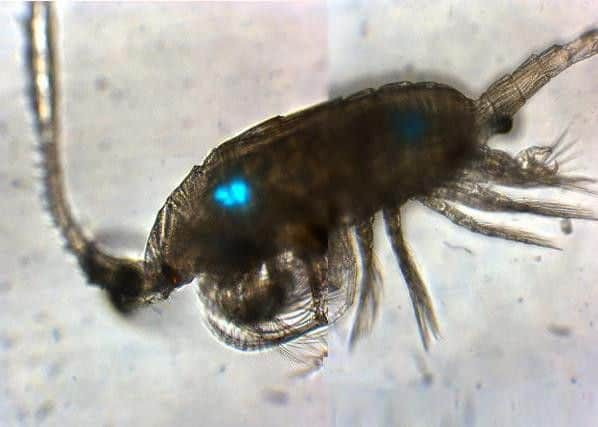MPs call for microbead ban after evidence shows plastic entering human food chain


Microbeads commonly found in hundreds of bathroom products are finding their way into the country’s most loved seafood dishes, including crab, mussels and lobster.
Shocking evidence presented to MPs, who are today calling for a ban on microbeads, shows that a plate of six oysters contains on average 50 ingested plastic particles and there are 36 particles per 100g portion of North Sea mussels.
Advertisement
Hide AdAdvertisement
Hide AdPuffins and seabirds at Bempton Cliffs in East Riding are also mistaking the small beads as fish eggs and some seabirds have been found to have so much plastic in their gut that it counts for 10 per cent of their body weight.


Environmental Audit Committee Chair Mary Creagh MP said: “Microbeads have been used in products since the 1990s and this year 68 tonnes of them went into the sea. Consumers are revolted by the idea we are polluting the marine environment and are horrified that labeling isn’t more clear.
“The microbeads in scrubs, shower gels and toothpastes are an avoidable part of this plastic pollution problem. A single shower can result in 100,000 plastic particles entering the ocean.
“We need a full legal ban, preferably at an international level as pollution does not respect borders. If this isn’t possible after our vote to leave the EU, then the Government should introduce a national ban. The best way to reduce this pollution is to prevent plastic being flushed into the sea in the first place.”
Advertisement
Hide AdAdvertisement
Hide AdMicroplastic pollution comes from the fragmentation of larger pieces of plastic waste, small synthetic fibres from clothing and the microbeads used in cosmetics and other products.


While most fish destined for human consumption have their gut removed beforehand, the plastic is present in shellfish.
Wakefield MP Ms Creagh said: “It’s in our lobsters, oysters and mussels. Which is horrifying, but it also does economic damage. We don’t know exactly what it is costing the fishing industry as it is slowing down the rate of growth and reproduction of shellfish.”
So far large cosmetics companies have made voluntary commitments to phase out microbeads by 2020. However, the committee found that a legislative ban would send a stronger message.
Advertisement
Hide AdAdvertisement
Hide AdMs Creagh said she would like to see a national ban on microbeads by the end of 2017, and if that fails they would like to clearer labeling during a transitional period.
Relatively little research has been done so far either on potential impacts to marine life, human health or the marine economy, and no studies have investigated whether microplastics ingested by humans can subsequently be transported into tissues.
However the report said: “Even for high level consumers of seafoods that are most likely to be relatively highly contaminated with marine microplastics, such as mussels or crab, dietary exposure to microplastic particles is likely to be relatively low compared with inhalation of microplastics.”
Research done on North Sea mussels found that the gut wall could stop microplastics from entering tissues, but very small particles could potentially pass through.
Advertisement
Hide AdAdvertisement
Hide AdTamara Galloway, Professor of Ecotoxicology at the University of Exeter, was an expert witness during the committee’s recent hearing in the House of Commons.
Following the report's release, she said: “Microbeads don’t biodegrade and instead accumulate in the oceans. Our research has shown that many marine animals ingest microbeads, mistaking them for food. They can become lodged in the animal’s gut, and prevent them from eating nutritious food. They can also pass chemicals into the animal’s tissues. When these animals are eaten, the microplastics and the chemicals they contain can be passed through the food chain too.
“It has been estimated that an average plate of oysters could contain up to 50 plastic particles. We don’t yet have any evidence for the harm that this might cause, but most people would probably prefer not to be eating microbeads with their food.
“The call for a UK ban is a very welcome step in the right direction. The best way to reduce marine pollution and protect marine animals from harm is to stop throwing things into the ocean in the first place.”
Advertisement
Hide AdAdvertisement
Hide AdThe investigation by the committee took several months and also heard from a wide range of experts, including Yorkshire Water.
They said their sewerage systems and treatment processes are not designed to remove microplastics and it is not a requirement of the Environment Agency to do so.
This led the committee to consider other ways of tackling the problem including better filtration systems on washing machines to catch the microbeads before they enter the water system.
Sewage companies could also have a role to play with upgraded systems, although even if they catch the beads they could form part of slurry, sprayed on farmers fields and eventually finding their way into soil.
Ms Creagh said: “There were moments where we sat there open mouthed thinking “this is disgusting”. When we found out we could also be breathing in micro plastics”.